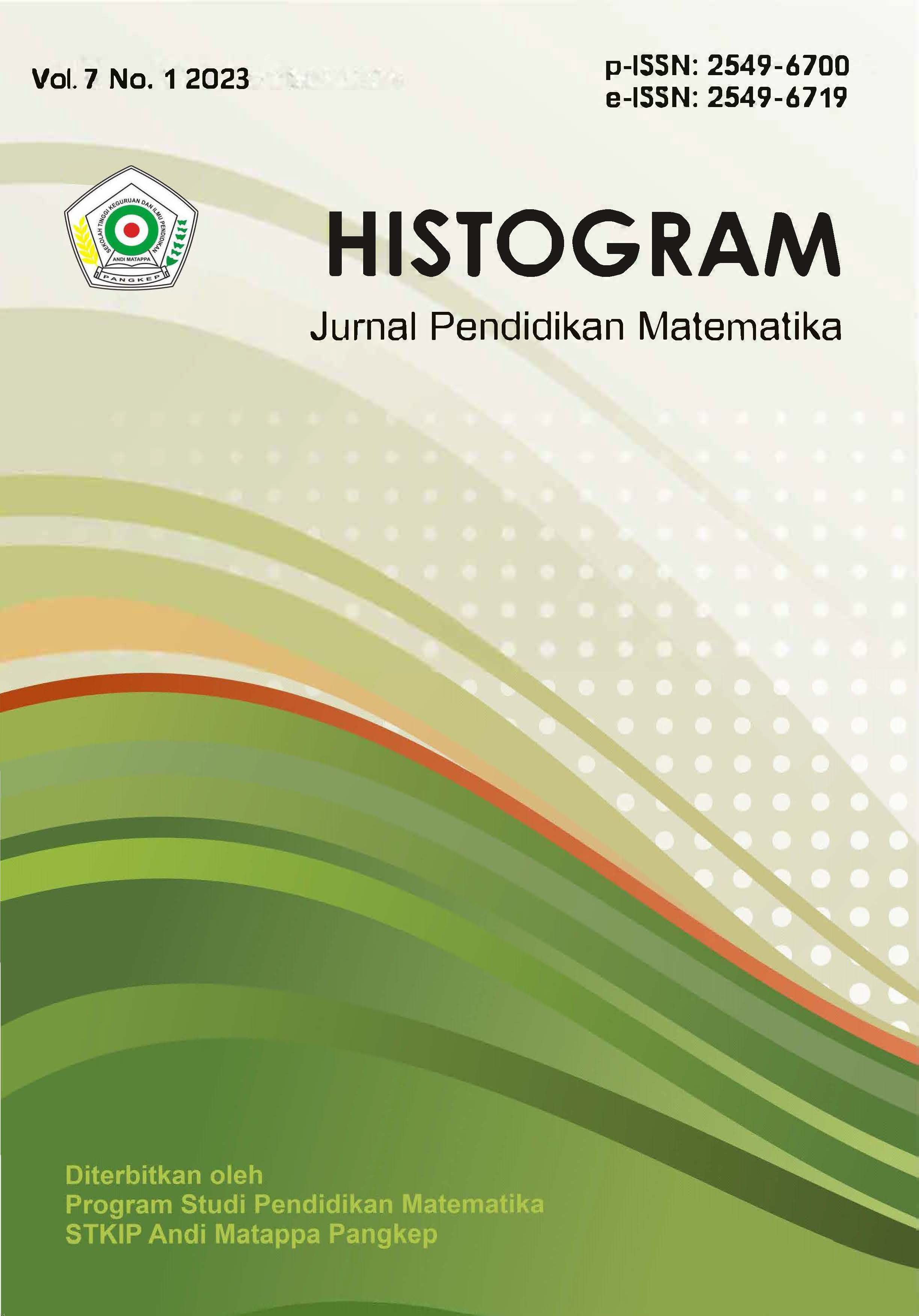PERKEMBANGAN KURIKULUM MATEMATIKA: BERDASARKAN TUJUAN KURIKULUM
https://doi.org/10.31100/histogram.v7i1.2520
Kata Kunci:
Kurikulum Matematika, Kurikulum, Pengembangan KurikulumAbstrak
Kurikulum merupakan pedoman yang digunakan untuk menyelenggarakan kegiatan pembelajaran yang berisi rencana, peraturan, tujuan, isi dan bahan pelajaran demi tercapainya tujuan pendidikan. Terdapat lima tujuan umum dalam pembelajaran matematika yang dirancang oleh National Council of Teachers of Mathematics (NCTM, 2000) yaitu pertama, belajar memecahkan masalah; kedua, belajar menalar; ketiga, belajar berkomunikasi; keempat belajar mengaitkan ide; kelima, belajar membuat representasi. Dengan berdasar pada lima tujuan pembelajaran matematika menurut NCTM mencakup belajar memecahkan masalah, menalar, mengkomunikasikan, mengaitkan ide, dan membuat representasi yang berarti perkembangan kurikulum matematika setidaknya mencakup kelima hal tersebut. Perkembangan kurikulum dari waktu ke waktu menuntut siswa untuk mandiri dan aktif serta dapat memahami dan memanfaatkan pengetahuannya. Dalam proses pembelajaran guru berperan penting dalam mengimplementasikan penerapan kurikulum. Siswa memang belajar mendapatkan informasi secara aktif, tetapi guru hendaknya dapat memilih dan menggunakan strategi yang tepat untuk melibatkan siswa aktif dalam belajar. Sebaik apapun rancangan kurikulum akan menjadi tidak berarti apabila guru sebagai pelaksana tidak dapat menguasai dan memahami kurikulum tersebut dalam kemasan pembelajaran yang baik dan bermakna.Unduhan
Referensi
Alhaddad, I. (2015). Perkembangan Pembelajaran Matematika Masa Kini. Delta-Pi, 4(1), 13–26.
Anggraena, Y. (2019). Pengembangan Kurikulum Matematika untuk Meningkatkan Kemampuan Siswa dalam Penalaran dan Pemecahan Masalah. Alifmatika: Jurnal Pendidikan Dan Pembelajaran Matematika, 1(1), 15–27. https://doi.org/10.35316/alifmatika.2019.v1i1.15-27
Departemen Pendidikan Nasional. (2001). Kurikulum Berbasis Kompetensi Mata Pelajaran Matematika Sekolah Menengah Umum.
Depdikbud. (1976). Kurikulum sekolah menengah 1975: GBPP Bidang Studi Matematika. Balai Pustaka.
Depdikbud. (1987). Bahan Penyajian Bidang Pendidikan Dasar dan Menengah pada Rakernas Depdikbud 1987. Departemen Pendidian dan Kebudayaan.
Depdikbud. (1994). Pedoman Pelaksanaan Kurikulum Pendidikan Dasar Sekolah Dasar. BP Dharma Bakti.
Depdiknas. (2002). Kurikulum Berbasis Kompetensi. In Jakarta Pusat (Issue 4). Pusat Kurikulum.
Kemdikbud. (2014). Kurikulum Tingkat Satuan Pendidikan pada Pendidikan Dasar dan Pendidikan Menengah. Peraturan Menteri Pendidikan dan Kebuduyaan Nomor 61.
Muhammad Kristiawan. (2019). Analisis Pengembangan Kurikulum dan Pembelajaran. Unit Penerbitan dan Pubikasi Univ. Bengkulu. https://www.researchgate.net/publication/339527344
NCTM. (2000). Executive Summary Principle and Standards for School Mathematics. The National Council of Teachers of Mathematics Inc. https://www.nctm.org/uploadedFiles/Standards_and_Positions/PSSM_ExecutiveSummary.pdf
OECD. (2018). PISA 2018 Results: What Students Know and Can Do: Vol. I. https://www.oecd-ilibrary.org/education/pisa-2018-results-volume-i_5f07c754-en
Peraturan Pemerintah Nomor 19. (2005). Standar Nasional Pendidikan.
S. Sukatin, & P. Pahmi. (2020). Kurikulum Sebagai Ujung Tombak Pendidikan dalam Mempersiapkan Generasi Bangsa. Jurnal Contemplate .
Undang-Undang Republik Indonesia Nomor 20. (2003). Sistem Pendidikan Nasional.
Unduhan
Diterbitkan
Cara Mengutip
Terbitan
Bagian
Lisensi
Please find the rights and licenses in Histogram: Jurnal Pendidikan Matematika. By submitting the article/manuscript, the author(s) accept this policy.
1. License
The non-commercial use of the article will be governed by the Creative Commons Attribution license as currently displayed on Creative Commons Attribution-ShareAlike 4.0 International.
2. Author's Warranties
The author warrants that the article is original, written by a stated author(s), has not been published before, contains no unlawful statements, does not infringe the rights of others, is subject to copyright that is vested exclusively in the author and free of any third party rights, and that any necessary written permissions to quote from other sources have been obtained by the author(s).
3. User Rights
Histogram: Jurnal Pendidikan Matematika's spirit is to disseminate articles published for free. Under the Creative Commons license, Histogram: Jurnal Pendidikan Matematika permits users to copy, distribute, display, and perform the work for non-commercial purposes only. Users will also need to attribute authors and Histogram: Jurnal Pendidikan Matematika when distributing works in the journal.
4. Rights of Authors
Authors retain all their rights to the published works, such as (but not limited to) the following rights;
- Copyright and other proprietary rights relating to the article, such as patent rights,
- The right to use the substance of the article in one's future works, including lectures and books,
- The right to reproduce the article for one's purposes,
- The right to self-archive the article,
- The right to enter into separate, additional contractual arrangements for the non-exclusive distribution of the article's published version (e.g., post it to an institutional repository or publish it in a book), with an acknowledgment of its initial publication in this journal (Histogram: Jurnal Pendidikan Matematika).
5. Co-Authorship
If other authors jointly prepared the article, any author submitting the manuscript warrants that all co-authors have authorized them to agree on this copyright and license notice (agreement) on their behalf and agree to inform their co-authors of the terms of this policy. Histogram: Jurnal Pendidikan Matematika will not be held liable for anything arising from the author(s) internal dispute. Histogram: Jurnal Pendidikan Matematika will only communicate with the corresponding author.
6. Royalties
This agreement entitles the author to no royalties or other fees. To such an extent that it is legally permissible, the author waives their right to collect royalties relative to the article regarding any use by Histogram: Jurnal Pendidikan Matematika.
7. Miscellaneous
Histogram: Jurnal Pendidikan Matematika will publish the article (or have it published) in the journal if the editorial process is completed. Histogram: Jurnal Pendidikan Matematika h editors may modify the article to a style of punctuation, spelling, capitalization, referencing, and usage that deems appropriate. The author acknowledges that the article may be published to be publicly accessible, and such access will be free of charge for the readers, as mentioned in point 3.






